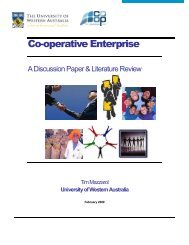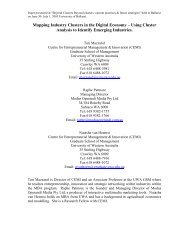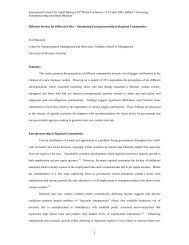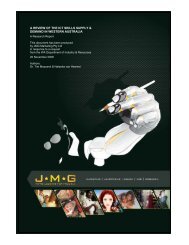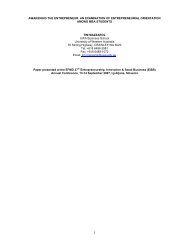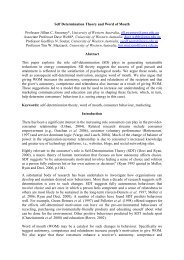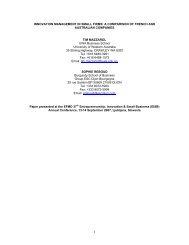The Future of Farming: Strategic Intent, Technology Diffusion ... - CEMI
The Future of Farming: Strategic Intent, Technology Diffusion ... - CEMI
The Future of Farming: Strategic Intent, Technology Diffusion ... - CEMI
Create successful ePaper yourself
Turn your PDF publications into a flip-book with our unique Google optimized e-Paper software.
Centre for Entrepreneurial Management and Innovation<strong>The</strong> <strong>Future</strong> <strong>of</strong> <strong>Farming</strong>: <strong>Strategic</strong> <strong>Intent</strong>, <strong>Technology</strong> <strong>Diffusion</strong> and Precision Farm Management3THE FUTURE OF FARMING: STRATEGIC INTENT,TECHNOLOGY DIFFUSION AND PRECISION FARMMANAGEMENTJoanne N. Sneddon, University <strong>of</strong> Western Australia (joanne.sneddon@uwa.edu.au)Tim Mazzarol, University <strong>of</strong> Western Australia (tim.mazzarol@uwa.edu.au)ABSTRACTThis paper examines the application <strong>of</strong> new technologies to precision agriculture, with specific reference to thewool industry in Australia. It argues that the adoption <strong>of</strong> new innovation is essential to the long-termsustainability <strong>of</strong> the industry, but cautions that the diffusion <strong>of</strong> such technologies is likely to depend on thestrategic intent <strong>of</strong> the wool producers. Multiple case studies are presented to illustrate how the strategicmanagement approaches adopted by wool producers will influence the potential adoption issues facing suchnew technologies. Propositions for the future diffusion <strong>of</strong> new technologies are outlined.Key words: strategic intent, innovation diffusion, farming enterprises.RESPONDING TO THE MARKET WITH INNOVATIONAgainst a backdrop <strong>of</strong> declining terms <strong>of</strong> trade and increasing competition it has become increasinglyimportant for Australian wool producers to adopt innovations that will have a positive impact upon enterpriseproductivity and pr<strong>of</strong>itability (Beare, 1999). Although innovative technologies are available to help woolproducers become more productive and pr<strong>of</strong>itable, change in the wool industry is slow compared with otherbroad acre enterprises (McLachlan, 1999). Wool producers have traditionally relied upon wool prices to liftpr<strong>of</strong>itability, rather than introducing innovations that will help reduce production costs or increase fibrequality (Burbidge 1999).<strong>The</strong> relatively low cost <strong>of</strong> managing pastures is considered to be <strong>of</strong> great international competitive advantageto Australia’s wool industry (Chapman and MacMillan 2000). However, much inefficiency exists within theAustralian grazing system with the average wool producer utilising around 30 per cent <strong>of</strong> green feed,compared with 80 per cent <strong>of</strong> feed utilised in intensive farming operations (Grimm 1998). <strong>The</strong> optimal greenfeed utilisation level for the average wool enterprise is around 60 per cent indicating a great potential forproducers to graze more sheep and grow more wool (Grimm 1998). <strong>The</strong> general under-utilisation <strong>of</strong> pastures isa result <strong>of</strong> producers stocking their wool enterprise to survive the poorest growing season rather than stockingto a rate that maximises the conditions <strong>of</strong> the actual season. This conservative approach to feed utilisation islargely due to the lack <strong>of</strong> reliable and timely pasture management information available to wool producers.In response to the underutilisation <strong>of</strong> green feed among wool producers, CSIRO and WA Department <strong>of</strong>Agriculture (WADA), in conjunction with the Western Australian Department <strong>of</strong> Land Administration (DOLA),formed a research consortium to develop remotely sensed pasture management technologies for woolproducers and other extensive graziers. <strong>The</strong> main objective <strong>of</strong> the consortium was to develop and deliverCentre for Entrepreneurial Management and Innovation | www.cemi.com.au



